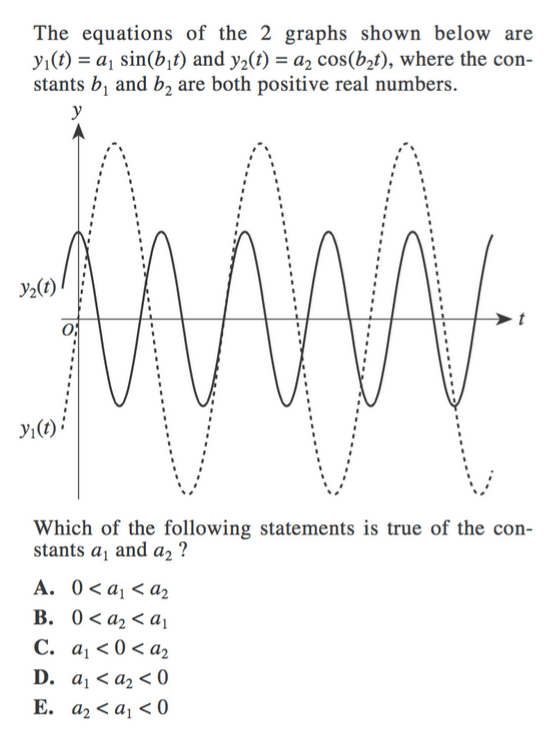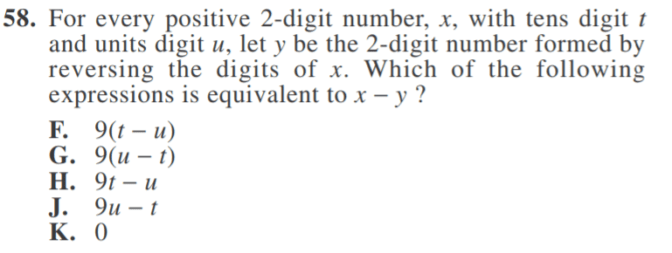
2020 ACT Math Study Guide -- Math ACT Guide
This guide focuses on explaining how to do the hardest ACT math problems. There is currently nothing like it available. However, it is under development and only partially completed.
Asymptotes
You should be able to find vertical and horizontal asymptotes for a rational function. For vertical asymptotes, you want to points which make the denominator 0. When it is 0, you will be dividing by 0, which makes the curve approach infinity or negative infinity as it approaches the point. For example is , the equation has vertical asymptotes at x = 2 and x = -4. You would set x-2 = 0 and x+4 = 0 to find those.
If the degree of the numerator is the same as the degree of the denominator, the horizontal asymptote is the ratio of the coefficients of the highest order term. The reason is that as x approaches infinity, the other terms will become insignificant. So in the example above, , the highest order terms are
. Therefore, the horizontal asymptote is at y = 3. If
, the horizontal asymtote is
.
If the degree of the denominator is higher than that of the numerator, then the horizontal asymptote is y =0. The reason for this is that is that as x gets large, the absolute value of the denominator will be much bigger than that of the numerator. For example, in , the ratio of the highest order terms is
, which goes to 0 as x goes to infinity or negative infinity.
Negative Reciprocal
If two lines are perpendicular, their slopes are negative reciprocals. You need to know that formula. If a line has slope 2, a line perpendicular to it will have slope . If a line has slope
, a line perpendicular to it will have slope
.
They may ask you the question straight out. They may also combine it with various ways to find the slope. For example, you may be given two points and asked to find the slope, then find the slope of a perpendicular. You may be given the equation in slope-intercept or standard form, and you will need to find the slope and then take the negative reciprocal. Methods for finding the slope are covered in the slope section of this guide.
Complex numbers
One type of problem asks you to square a complex number. For example, you may be asked to find . In this case, you need to foil it out,
. We used the fact that
.
Another type of problem is the product of two complex numbers is 5 and one of them is 2 + i. The easiest approach is to realize that the other has to be the conjugate, 2- i. If you don’t see that, you take , then you multiply the top and bottom by the conjugate, 2 – i.
.
Another problem is to ask the product a + bi and what is a real number. Again, they are asking for the conjugate, and the answer is a – bi.
They may also ask you to convert to a complex number.
. Therefore, the answer is
.
Sum of angles in polygon
The formula for the sum of the interior angles in a polygon is , where n is the number of sides. So a triangle has
, a quadrilateral
, a pentagon
, and hexagon
, and so on. The formula can be derived from the sum of each interior and exterior angle being
and the sum of the exterior angles is
. So
is the sum of the exterior and interior angles and
subtracts the exterior angles.
So each interior angle in a regular polygon is . This can also be expressed as
, which is subtracting off the exterior angle.
The formula may or may not be given. You may need to find the interior angle or the sum of the interior angles. You may be given one angle and asked to find the sum of the other angles.
Logarithms
There are various types of log problems, so I will discuss them all.
One problem asks for the . This is the same as asking you what
equals.
Alternatively, you can take
. You can also take
with your calculator. A brute force approach would be to plug in each answer choice and find the log(16) using to change of base formula and see which gives
.
.
Another problem asks the . You should recognize that
, so the answer is 4. Using the change of base formula, you can also take
.
You could be asked if , what is x? You should know that
, so the answer is 3. A brute force approach is
, so 3 logx = log 27.
If you are asked , this equals
by the laws of exponents, which equals -5. Another approach is to use the laws of logarithms,
. You can make up numbers and do
.
The laws of logarithms are log ab = log a + log b, log = log a – log b, and log
= bloga. These can be derived from logarithms being exponents.
So . You may be asked to perform operations in either direction, expanding or contracting logarithmix expressions.
Absolute Value
A relatively simple absolute value problem is |3x-2| = 7. By the definition of absolute value, what is inside the absolute value signs can equal 7 or -7. So 3x-2 = 7 or 3x -2 = -7. 3x- 2 = 7, 3x = 9, x = 3. Or 3x – 2 = -7, 3x = -5, x = –.
There is a trick problem |3x -2| = -4. The answer is no solution, because an absolute value can never be negative. If you work the problem, you will get solutions, but they will not check.
Another way of asking this is for what values of a is |2x -5| = a undefined. The answer is any value of a < 0, as the absolute value can never be negative.
Absolute value inequalities are trickier. If you have |3x-2| < 7, you need to take the negative of what is inside the absolute value to avoid getting the wrong direction of the inequality. So 3x-2 < 7 or 2-3x < 7. 3x -2 < 7, 3x < 9, x < 3. Or 2 – 3x < 7, -5 < 3x, < x. So
< x < 3. In interval notation, (
, 3).
A hard type of absolute value problem is if you are asked to solve . You need to split it up into 2 problems,
for x > 0 and
for x < 0. The first quadratic can be solved
, (x+5)(x-2), x = – 5 or x = 2 for x > 0. Similarly, the second quadratic can be solved x = 5 or x = -2 for x < 0. You could also use the quadratic formula or other methods to solve the quadratics. Only the positive solution works for the positive range and the negative solution for the negative range, so the answer is -2, 2.
An even harder version of the above problem asks you to solve . Foiling, you get
.
is always
. Therefore, we have
. This can be split into
for x>0 and
for x < 0. For the first inequality, solving the quadratic, the critical points are -1 and 3; plugging in 0, we get
, which is true, so
for x > 0. Similarly, for the second inequality, we get
, for x < 0. We take only the relevant part of both ranges, and get the answer
. It is possible to guess answers by plugging in numbers, and that approach might be useful, as the above analytical solution is very difficult.
Another problem asks what is not in the domain of . This is the same as asking for the vertical asymptote; it is asking for when we are dividing by 0. So you set the denomonator equal to 0. |x| -11 = 0. So x – 11 = 0 or -x -11 = 0. x = 11 or -11
A problem is |y| = y + 11. Then either y = y + 11 or -y = y + 11. If y = y +11, 0 = 11, which is impossible. -y = y + 11, -2y = 11, y = , which is the answer.
They could ask if a part has to be between 6.85 and 7.15 cm how to express that with absolute value. That is . That is it can’t be more than 0.15 away from 7.
If you are shown a graph and asked which graph is the absolute value of it, the current answer is the position y-values should remain the same. However, the negative y-values, should be reflected about the x-axis, making them positive.
Circle Graph
A common type of problem asks you to convert a percentage to degrees on a circle graph. To do this, multiply the percentage by 3.6 to get the number of degrees on the circle graph. This is because there are 360 degrees in a circle and 100 percent is 1. So multiply by . You may have to first determine the percentage and then convert it to degrees of a circle.
Circles
Equations of Circles
The basic equation of a circles centered at the origin is , where r is the radius of the circle. This can be derived from the Pythagorean Theorem. A circle is defined as the set of points equidistant from a fixed point, so the combination of x and y values will equal the radius. For example, a circle centered at (0,0) with radius 5 has the equation
.
If a circle is centered at another point, (a,b), the equation of the circle is . For example is the circle has center at (11, -7) and radius 10, the equation of the circle is
. Not just circles, but other conic sections such as parabolas and ellipses and trigonometric functions are offset the same way, you subtract the coordinate from the variable. <discussion of problems needs to be added here>
Chords of Circles
Area, circumfrence, and radius of circle
The circumfrance of a circle is . The radius is
. r is the radius.
s
Trigonometry
Right triangle trigonometry
Finding one trig function with another
Trigonometric Equations
Converting between radians and degrees
There are 360 degrees in a circle and radians in a circle. Hence to convert radians to degrees you multiply by
. To convert degrees to radians, you multiply by
. <more>
Coterminal angles
solving trigonometric equations
Laws of sines and cosines
The purpose of the laws of sines and cosines is to solve triangles that are not right triangles. You need three pieces of information about angles and sides and you can find all the angles and sines. The law of sines is easier and requires an angle and an opposite side and one other piece of information. The law of cosines works when the law of sines does not work. To use the law of cosines, you need 3 sides or 2 sides and the angle between them. You will be given the formulas for these laws and do not have to memorize them. You need to know how to use them correctly.
The law of sines is . Angle A is opposite side a and so on. So for example if
, side a = 10 meters,
, we can find side b. In this case, it is easier to use the form
. So
.
, since all the angles in a triangle add up to
, so we can find side c in similar fashion. It is possible there can be more than one possible triangle with the law of sines, but you don’t need to know that for the ACT.
y
Probability
Combinations
Slope
Midpoint formula
The midpoint formula is . This means you take the average of the x’s and the average of the y’s. A frequent low to mid numbered problem just asks you to apply the midpoint formula. For example, if you have two points, (1,2), and (5, 12), the midpoint is
.
Distance formula
The distance formula is derived from the Pythagorean Theorem, . c is the distance, the hypotenuse of the right triangle. So taking the square root of both sides,
. a is the distance along the x,
, and b is the distance along the y,
. Substituting, distance =
. You may just be asked to apply the distance formula. You may also be asked to find the distance multiplied by some scale factor. Occasionally, you will have to use large values for the x and y. You can apply the Pythagorean Theorem directly rather than use the distance formula as such.
cf
Rates
Two equations and two variables
Properties
Graphing Inequalities
Translations and Transformations
Proportions
Average
Sequences and Series
Percentages
Elipses
ACT Math Study Guide








The ultimate guide to the math ACT. Study this ACT math study guide. before you take the math ACT in 2020. Also included are ACT math formulas, ACT math problems, and ACT math tutoring. Don't take the math ACT with studying this ACT math guide for 2020.

